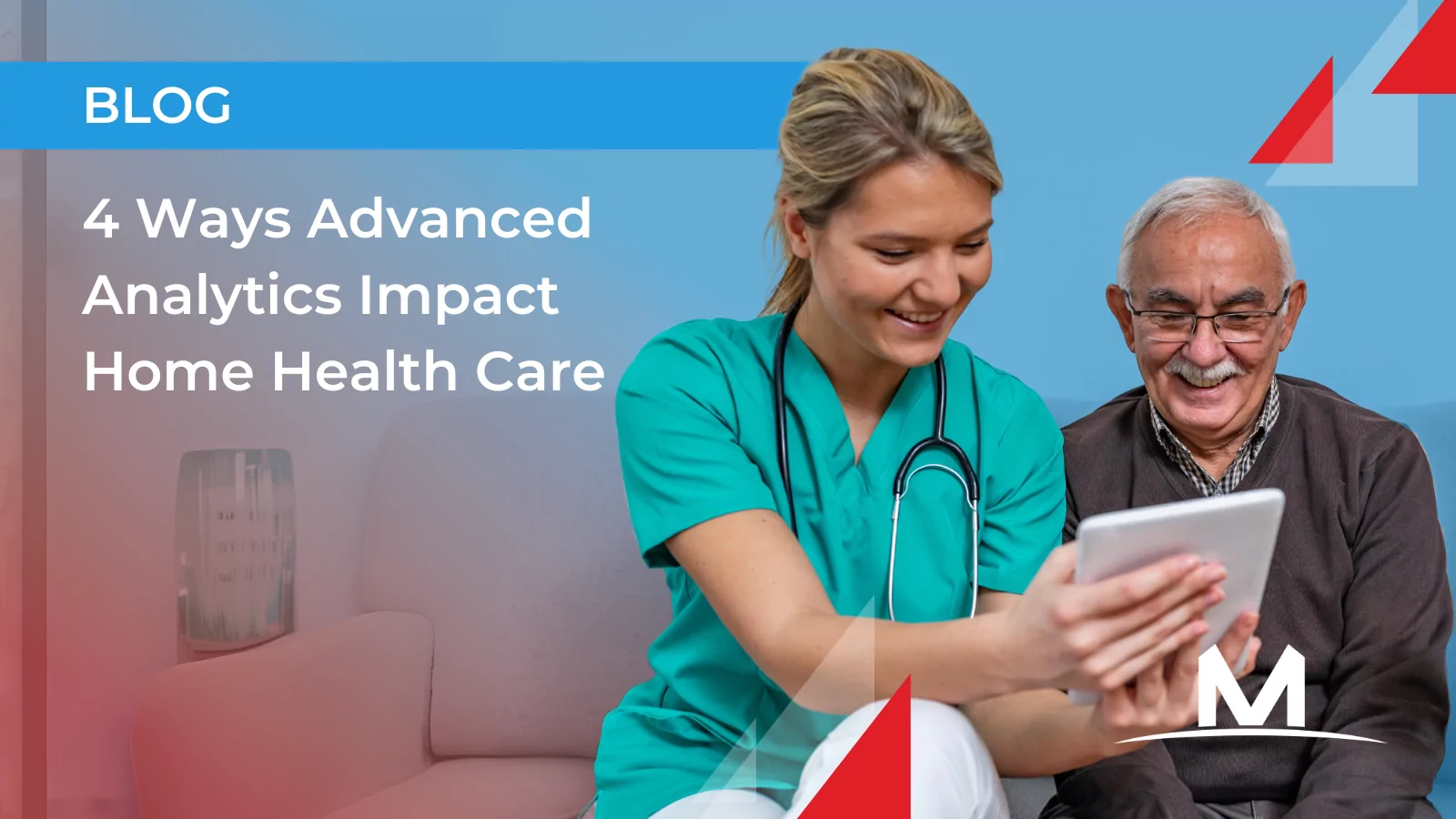4 Ways Advanced Analytics Impact Home Health Care

Author: Shea Swenson
Posted: December 17, 2024
Transform Your Home Health Agency with Advanced Analytics
The U.S. home health industry provides a wide range of medical services similar to those offered in hospitals—all from the comfort of a patient’s home. With the growing elderly population, home care services are becoming increasingly popular due to the rising demand and the personalized, convenient care it offers. Specifically, according to the United Health Foundation 2022 data, around 17.5% of the total U.S. population are 65 years and older.1
So what is driving the shift towards home health care? It largely stems from the modernization of home care technology and the availability of insightful home health analytics. With tools like EMRs and predictive analytics, agencies can now make informed, data-driven decisions. However, the key to success lies in leveraging these tools effectively. Recognizing the importance of home health analytics can improve patient outcomes, streamline agency operations, and transform the overall landscape of home care.
Why Are Advanced Analytics Important in Home Healthcare?
The U.S. home healthcare industry was valued at $95.45 billion in 2023, with a projected growth to $176.30 billion by 2032.1 Amid such exponential industry growth, advanced analytics are essential for home health organizations looking to optimize the patient care experience. These advanced home health analytics provide key insights to improving patient outcomes, identifying patient trends, creating operational efficiencies, and more.
How Do Home Health Analytics Impact Care?
1. Improve patient outcomes
Advanced home health analytics significantly enhance patient outcomes in home healthcare by leveraging the latest technology and tools. These innovations allow agencies to access resources that improve care delivery by providing insights to monitor and predict patient health trends, consolidate patient data in electronic health records (EHRs) for easy tracking by clinicians, and support a more tailored approach to care. For instance, research shows that around 89% of home health and hospice organizations reported increased efficiencies with their use of EHR systems.2 Additionally, the use of AI in healthcare analytics can reduce hospital stays by 20%, and readmissions by 25%.2
By using these tools, agencies can better harness their data for a more proactive role in managing patient health, intervening early when issues arise, and tailor care to specific needs of individuals. As a result, home health agencies not only optimize care delivery but also significantly enhance the overall patient experience, leading to higher satisfaction and better long-term health outcomes.
2. Predictive analytics for preventative care
Predictive analytics in home healthcare takes on a “proactive rather than reactive” approach to care.3 Preventative analytical tools can help:
- Identify high risk patients: Predictive analysis utilizes patient data to pinpoint those at risk of hospital readmissions or specific complications. Accurate and updated data prediction tools can surpass timeliness and accuracy of clinicians.
- Tailored treatment plans: Patient data can be used to customize treatment plans to fit the individual’s needs, resulting in better care and reduced likelihood of hospitalizations and readmissions.
- Monitor chronic conditions effectively4: Along with customized treatment plans, clinicians can better monitor chronic conditions by quickly adjusting care strategies or perform preventive measures.
Most agencies have adopted analytic solutions to monitor processes. However, when agencies make full use of advanced analytics, they can better evaluate patient data to drive early interventions and preventative care—ultimately reducing hospitalizations, readmissions, and overall healthcare costs.
3. Data-driven decision making for enhanced patient care
Data-driven decisions ensure that everyone involved in a patient’s care journey—clinicians, patients, family members—are on the same page through improved communication, accessible patient data, and real-time updates. By basing home health care on real-time, accurate data, providers can optimize their time and resources to provide better value-based care.
Real-time data allows for the quick identification of health trends or issues, enabling proactive interventions before problems escalate. Not only does this enhance the quality of care but also helps providers allocate time and resources more efficiently, leading to better value-based home health care.
The use of data analytics is growing in the healthcare industry, with 60% of health care executives currently using health care data analytics in their organization, according to a Society of Actuaries survey. Of those, 42% saw improved patient satisfaction, and 39% reported cost savings.5
4. Agency operational efficiency and financial management
We’ve covered how advanced home health analytics improve efficiencies on the patient level, but how do they impact the home health care agencies themselves? Advanced analytics can help uncover a wealth of agency insights around staffing, revenue cycles, and more. Home health agencies can then utilize this data to optimize their resources and streamline processes:
- Scheduling and routing optimization: analytics tools can help schedule home visits, provide optimal routes, decrease clinician travel time, and reduce overall costs.
- Staffing management: analytics can be used to predict care demand, manage staffing and provide the right provider to the right patient. Advanced analytics can also help reduce clinician burnout that is typically associated with staffing issues.
- Manage revenue cycles: help ensure all services are billed accurately and reimbursements are maximized.4
- Navigating regulatory compliance: ensuring that agencies’ practices align with the latest regulations, monitor compliance status more efficiently, and anticipate trends and changes in regulations.4
MHA Difference — Shaping the Future of Advanced Analytics in Home Health Care
At MHA, we’re improving patient outcomes with tech-enabled solutions designed for home health and hospice agencies. Our cutting-edge technology is transforming the industry through the use of advanced analytics and data-driven insights to enhance efficiency and care quality in the home health sector.
NOTIFYnana: This text-based solution bridges the gap between patient and clinician communication. By leveraging patient demographics and visit schedules, NOTIFYnana sends text notifications to patients about their caregiver's arrival. It also assesses patient sentiment and satisfaction post-visit, offering real-time feedback.
nanaCONNECT: Our solution seamlessly connects patients with clinicians through daily insights, text messages, simple rating systems, and dashboard analytics. nanaCONNECT helps reduce costs, improve patient outcomes, boost satisfaction, and enhance care with insightful data-driven tools.
Ready to elevate your agency's outcomes and harness the power of home health analytics? Schedule a demo of our tech solutions today or visit www.maxwellhca.com to learn more about how MHA is transforming the home health and hospice industry. Contact us at [email protected] to level up your agency’s home health practices today!
Resources:
- https://www.fortunebusinessinsights.com/u-s-home-healthcare-services-market-105568
- https://media.market.us/home-healthcare-statistics/
- https://news.bryant.edu/are-predictive-analytics-key-reducing-costs-improving-healthcare-one-expert-thinks-so
- https://www.redroadhbs.com/post/data-driven-decision-making-in-home-health-care
- https://healthadministrationdegree.usc.edu/blog/how-health-care-data-analytics-improves-quality-care

